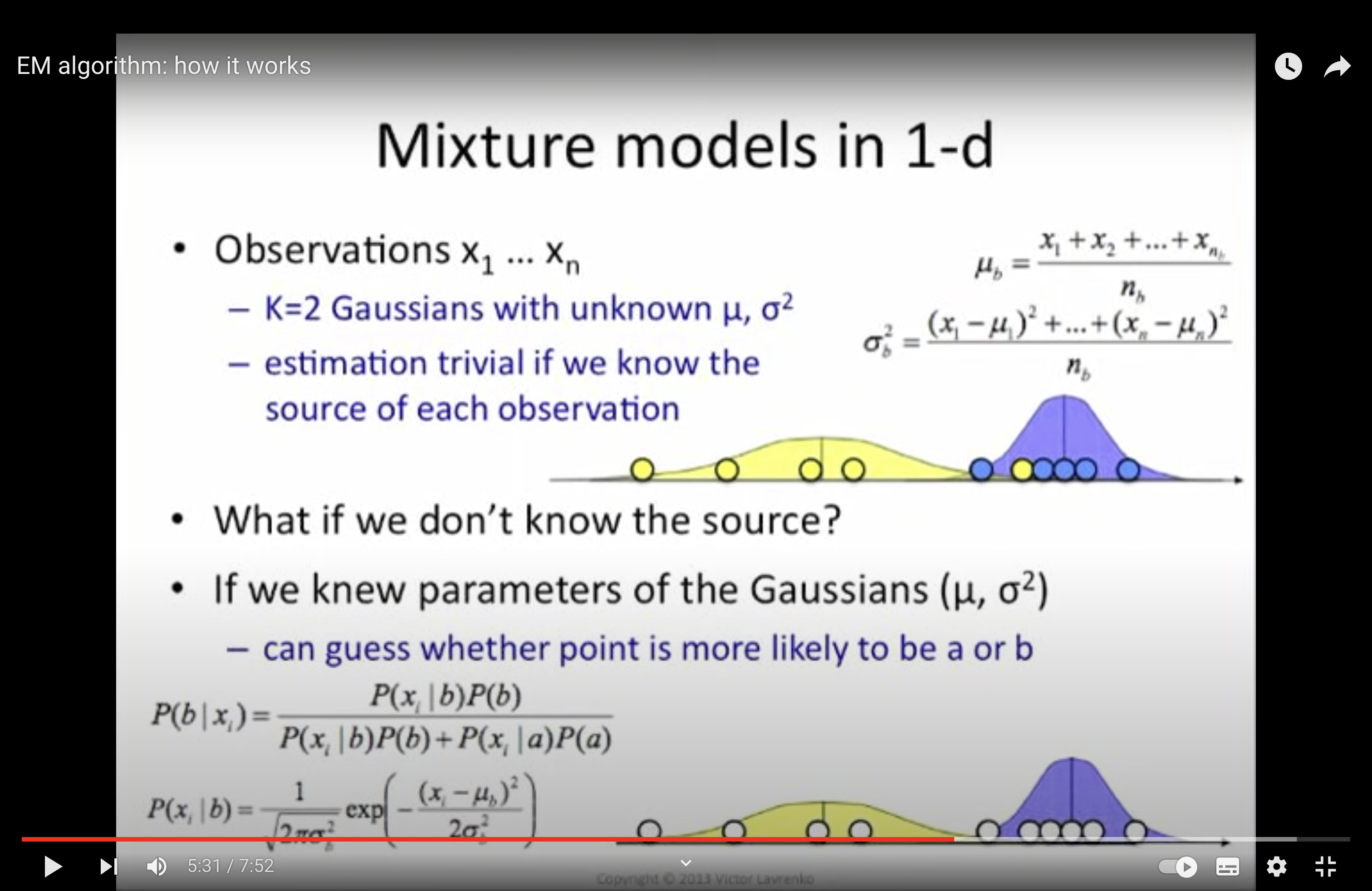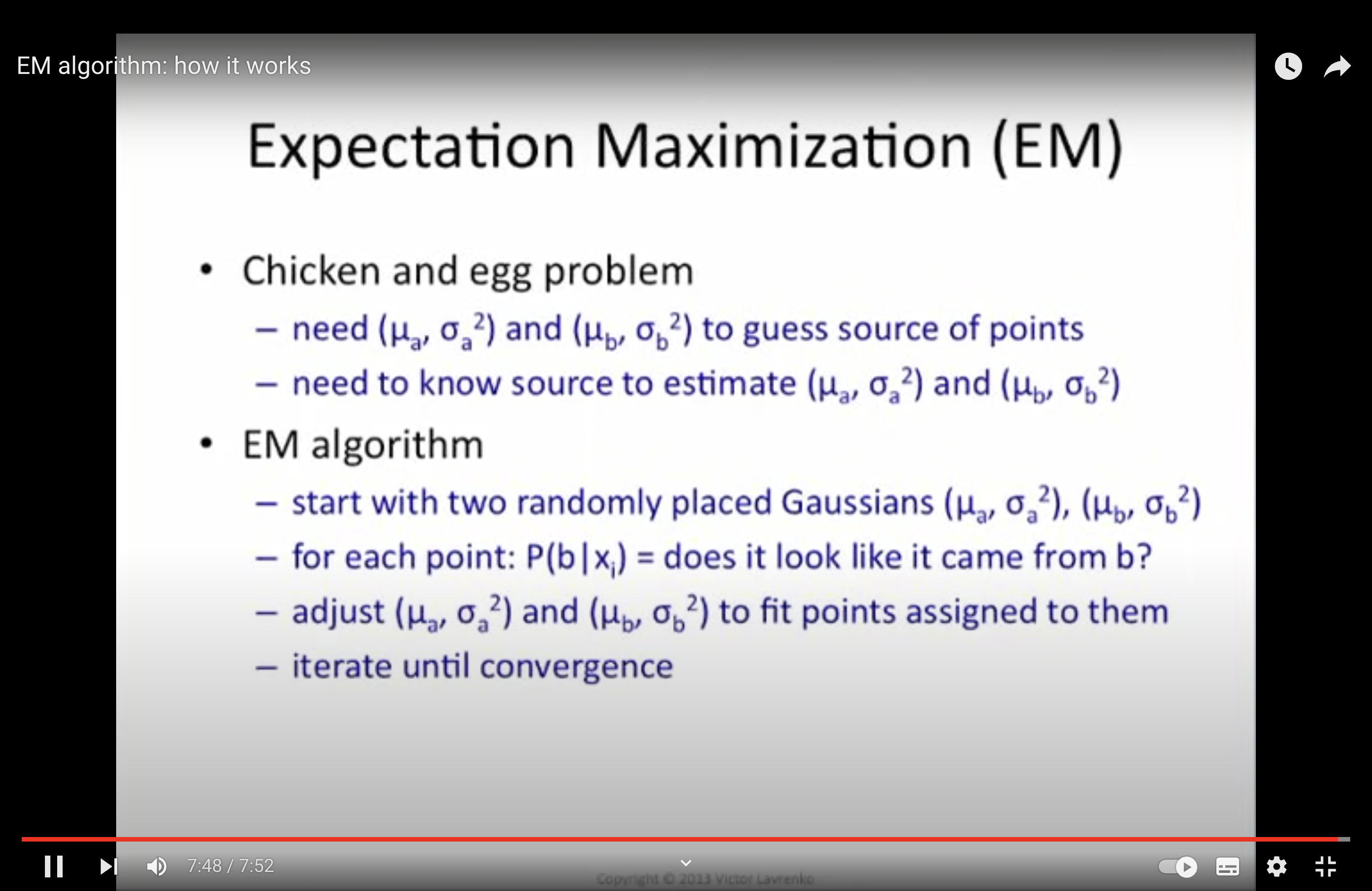Review 5#
This notes is completed with assistance of ChatGPT
ToC#
Probabilistic Graphical Models
representation, inference
Hidden Markov Model
Gaussian Mixture Model
HMM#
Learning Resources#
KNN & Kmeans#
Feature/Aspect |
K-NN (K-Nearest Neighbors) |
K-Means |
|---|---|---|
Type of Algorithm |
Supervised Learning |
Unsupervised Learning |
Purpose |
Classification or Regression |
Clustering |
Input Data |
Labeled data for training |
Unlabeled data |
Output |
Predicted label/value |
Cluster centroids |
Training Requirement |
Yes, stores all training data |
Yes, finds centroids |
Prediction Mechanism |
Votes from ‘K’ closest points |
Assigns to nearest centroid |
Parameter ‘K’ |
Number of neighbors to consider |
Number of clusters |
Distance Metric |
Typically Euclidean, but can be others |
Typically Euclidean |
Sensitivity to Outliers |
Sensitive (depends on ‘K’) |
Can be sensitive |
Scalability |
Can be computationally expensive for large datasets (unless optimized e.g., with KD-trees) |
Can be more scalable with techniques like MiniBatch K-means |
Real-time Updates |
Easy, just add data to dataset |
May require re-running the algorithm |
Interpretability |
Direct relationship between input and output based on distance |
Centroids represent cluster ‘centers’ but may not correspond to actual data points |
Gaussian#
List two similarities and two differences between K-means and Gaussian Mixture Model
Similarities:
Objective: Both K-Means and GMM are used for clustering, that is, partitioning a dataset into groups (clusters) based on similarities.
Initialization: Both can use similar initialization techniques. For example, the initial cluster centers in K-Means can be used as the initial means in GMM.
Differences:
Model Assumption:
K-Means: Assumes that clusters are spherical and equally sized. It achieves this by assigning points to the nearest centroid based on Euclidean distance.
GMM: Assumes that data is generated from a mixture of several Gaussian distributions. Each cluster can have a different elliptical shape, size, and orientation because GMM captures the variance and covariance of the data.
Soft vs. Hard Assignment:
K-Means: Performs hard assignments, meaning each point is assigned to one and only one cluster.
GMM: Performs soft assignments, meaning each point is assigned a probability for each cluster, indicating how likely it belongs to the cluster. This allows for a more nuanced understanding of cluster membership.
While K-Means can be thought of as a special case of GMM where each cluster’s covariance along all dimensions approaches 0 (leading to spherical clusters), GMM provides a more general and flexible approach at the cost of being computationally more expensive.
How many free parameters do we need at least for a Gaussian Mixture Model in a D-dimensional space with k clusters?
For a Gaussian Mixture Model (GMM) in a \( D \)-dimensional space with \( k \) clusters, the free parameters include:
Means: For each of the \( k \) clusters, we have a \( D \)-dimensional mean vector. Total parameters for means = \( k \times D \)
Covariances: Each cluster has a \( D \times D \) covariance matrix. However, since the covariance matrix is symmetric, the number of unique values in the matrix is \( \frac{D(D + 1)}{2} \). Total parameters for covariances = \( k \times \frac{D(D + 1)}{2} \)
Mixture weights (priors): For \( k \) clusters, there are \( k \) mixture weights. But they sum to 1, so you only need to know \( k - 1 \) of them to determine the last one. Total parameters for mixture weights = \( k - 1 \)
Now, summing up all the parameters: Total parameters = \( k \times D + k \times \frac{D(D + 1)}{2} + k - 1 \)
Let’s simplify this expression.
The total number of free parameters for a Gaussian Mixture Model in a \( D \)-dimensional space with \( k \) clusters is given by:
This formula accounts for the means, covariance matrices, and mixture weights for each of the \( k \) clusters in the \( D \)-dimensional space.
EM#
soft assignment: computes the prob this point comes from this/that distribution


